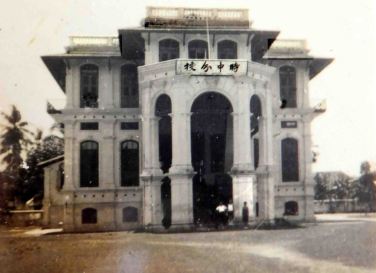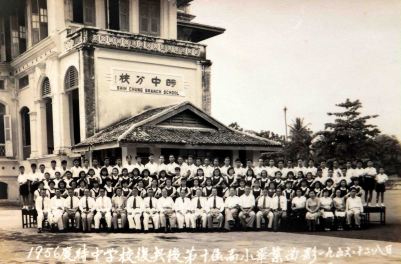‘If history were taught in the form of stories, it would never be forgotten.’ Rudyard Kipling
Have you ever looked at an old building in Penang and wondered about its past? If you have, you may want to look out for old Penang postcards. They offer pictorial records of Penang landmarks and if like me, you enjoy stretching your imagination, they can be a source of many intriguing tales!

Have you noticed this dilapidated building along Northam Road? The one opposite Thirty Two at The Mansion? The building that once housed Shih Chung Branch School? Yes, the building that gives some people an eerie feeling when they look at it?
My husband and all his five brothers as well as most of his sisters studied at Shih Chung Primary School. Naturally, the building was often the topic of conversation at family gatherings! And that, obviously, is another reason I am prompted to write about this landmark!
Like many other Penang buildings, this building has gone through turbulent times over a period of about one-hundred and thirty years! And with some creativity, you can actually spin quite a few spooky tales about it!
However, judging by the publications and blogs on the place, I realise that this building has attracted loads of attention! Moreover, it has such a long history I would be doing it a big injustice if I were to just weave my own stories!
My major challenge now is to make sure my blog doesn’t read like an extract from a history textbook!

Once upon a time, and that was in the 1880s, a wealthy Penang Hokkien businessman, Cheah Tek Soon and his brother decided to build the first five-storey building in Penang! This magnificent palatial building was to be the family residence.
In those early days, the Penang Chinese obviously didn’t mind flaunting their wealth! Maybe people then didn’t have to worry about crime, and so the Cheah family took pride in showing off their wealth with a lavish lifestyle.
However, priorities change with the times! The next generation of Cheahs believed that reforming China was of greater importance than showing off! The magnificent building was sold in 1908 and the proceeds of the sale magnanimously used to help finance the Chinese Revolution led by Dr Sun Yat Sen.
So who bought the property? The buyer was Tye Kee Yoon a wealthy Hakka merchant. He was also the Chinese Manchu Vice-Consul of Penang! I am baffled! Why did he purchase the property, knowing that money from the sale would be used to fight the Manchu government he represented?
From 1908 he is said to have resided in the building and used it as the Chinese Consulate. But if he stayed there at all, it must have been just for one or two years! Old postcards, some with cancellations, show that the building ran as a hotel from about 1910!
I leave you to speculate on why he bought such an imposing building if he didn’t intend to stay! Was something wrong with the ‘feng shui’ of the place? Did he buy it just as an investment? If you have an answer, share it with us!
The building was used as a hotel from 1910 to 1915. It may interest you to know that hotels by five different names occupied the premise during those five years! What actually happened?

My guess is that it started off as Norman Hotel, and was then renamed Bellevue Boarding House, Bellevue Hotel, Raffles Hotel and Raffles by the Sea, probably in that order.

I believe the same proprietor ran all five hotels. This may be speculation on my part, but then, a change of proprietor would have taken time! To have five different proprietors over a period of five years would have been near impossible!

Moreover, Bellevue Hotel and Raffles by the Sea even shared the same postcard! The only differences being that the later postcard was printed in colour and carried a different caption!

It’s quite obvious the hotel venture was a failure! Did the Tyes have a hand in the running of the hotel or was it leased out? Why did it fail? Why was the hotel renamed so many times? Will the mystery ever be unveiled?
It would appear that from the day it was purchased, the building was destined not to make money for the Tyes! It obviously was a failure if it was a business venture!
Maybe it was fated that the building be used for education. So, from 1915, several schools occupied this building, some for many years!
In 1915, Tye Kee Yoon allowed the building to be used as Pi Joo Girls’ School. This school was started by the son of his good friend, another Hakka by the name of Leong Pi Joo. Leong must have been a pretty open-minded man as he believed in a proper education for girls!
But luck did not favour the female gender then; this primary girls’ school had to close in 1920. The story goes that it was because of some new government regulation in the Education Bill of 1920.
From then on, the British Government leased the premise from the Tyes and used it as an English School. I am not sure how long the Government English School occupied the premise but I do know for sure that the building was left unoccupied for a few years before Shih Chung Branch School finally moved in in 1938.

And what makes me so sure about this part of the history of this building? Hey, my father-in-law, Khong Kwot Seong, was Headmaster of Shih Chung Primary School for a good thirty over years from 1930!
He was a Chinese educationist, and thank heavens, a prolific writer! A lot of the material here is derived from two of his articles, ‘Sixty Years History of Chinese Education in Penang: 1900 and Later’ and ‘Biography of Liang Pi Joo’.
Of course the articles were in Chinese! And since I am illiterate there, I must thank my husband who patiently translated these articles for my benefit.
Unfortunately for everybody, the Second World War started, and from 1941-1945, the building was taken over, firstly by the British and then by the Japanese. The premise was supposedly used by the respective governments of the time, but stories go that the basement was used to house prisoners!
What happened in the building during those five years is something I won’t speculate on. I leave it to you to stretch your imagination!
After the Second World War, the British Government took over the building again! Why they wanted the building intrigues me! Were they hoping the Japanese had left something behind? Or was it because this happened to be one of the few buildings in reasonably good shape after the war? After all, the ruling governments were using the premise during the turbulent times!
Chinese educationists appealed for the return of the building so it could be used as a school; and the British finally surrendered the building to the Tye Trust in 1949.

In 1950, Shih Chung Branch School finally returned to the premise! My husband proudly reminds me that he joined the school that same year!
From then on, the very generous Tye Trustees donated $1,000 annually towards the renovation and running of the school. The school fared well for at least the next twenty years after that.
However, the falling student enrolment in later years forced Shih Chung Branch School to finally move out in 1994. That year saw the end of the building’s eighty year love affair with schools.
From then on, the grand building was left to rot. The Tye Trustees finally sold the building off in 1993.
Today, the building stands without a roof and the grounds are used as a car park. Meanwhile, stories are told of a horrifying suicide and a fire in the building. Tales of the supernatural kind abound! Are these fabricated?
All attempts at development on the site have failed because of heritage requirements. The last I heard was a proposal to build a columbarium there. Can you imagination the reaction of the Penangites to this proposal? So, the building now stands in a dilapidated state – a far cry from its days of glory!
Many intriguing stories can be crafted based on the history of this building. Every phase, from the time it was used as a residence, to the time when it was a hotel, to the days when the Japanese occupied the place can serve as the background for many fascinating as well as hair-raising stories.
Come to think of it, there is even scope for award winning novels or movies related to this building! That would put the building back in the spotlight! After all, empires fall, sometimes to rise again! So, hopefully, this landmark building can see ‘paradise regained’ one day!
It could join the increasing budget hotels to provide accomodation to travellers of the tourist trade
LikeLike
I was really young when I remembered first seeing this building. I’ve always been curious about what happened to the school and why is it deserted. Thank you so much for your blog, the building is truly magnificent-looking in its prime. 😍
LikeLike
Glad you enjoyed the blog! Good to come ‘meet’ someone who loves heritage!
LikeLiked by 1 person
Wow thanks for sharing the comprehensive history of this mysterious house! I walked past it when I visited George Town last month and it has intrigued me since. If walls could speak, indeed. But thanks to you and your hubby, we have this inside story. I hope they won’t tear it down. It should be restored it to its former glory for the succeeding generations to enjoy and experience.
LikeLike